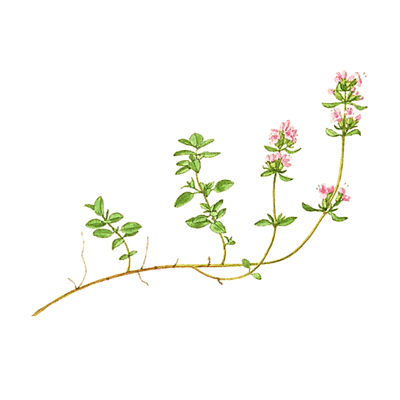Thymus
"Wild Thyme"
Tphymus pulegioides

T. citriodorus (lemon thyme); T. pulegioides (wild thyme, mother-of-thyme, creeping thyme); T. vulgaris (common thyme, garden thyme) An essential ingredient in the cook's most basic bouquet garni, thyme has been cultivated since the days of ancient Greece for its strongly aromatic, slightly pungent foliage. The low, shrubby perennials in this large genus of more than 100 species vary from 1 to 12 inches in height and can be differentiated by the appearance and fragrance of their leaves, the upright or reclining position of their stems, and their flowers. All thymes have thin, woody, twiglike stems with small, shiny oval-shaped leaves approximately 1/4 to 1/2 inch long. In the early summer, rose, lilac, pink, crimson, or white flowers appear at the ends of the stems or in whorls where the upper leaves join the stem. Bees love the flowers.
Common thyme and lemon thyme are popular for cooking while wild thyme is chiefly grown as an ornamental garden herb. Common thyme, the tallest of the three, also has the strongest scent and flavor; it forms upright bushes 6 to 12 inches high. There are two principal varieties of common thyme: English or broad-leaf thyme; and French summer or narrow-leaf thyme.
Lemon thyme closely resembles common thyme except for its intense lemon scent. Its leaves are slightly broader and its stems semitrailing. One variety of lemon thyme has yellowish-green leaves and grows only 6 inches high; it is used as a fragrant ground cover.
Wild thyme, often called mother-of-thyme because it is thought to be one of the original thymes, is acreeping, delicate-appearing but tough species cultivated for its aromatic carpet-like growth. The numerous varieties of wild thyme differ in flower color and the size and shape of the leaves.
HOW TO GROW. Except for the Gulf states, thymes grow throughout the United States. Most are hardy in Zones 4-10. They thrive on full sun and grow best in light, well-drained soil with a pH of 5.5 to 7.0. Plants can be grown from seeds but seedlings often differ in size, color, and fragrance, so this herb is commonly grown from root divisions made in the spring or stem cuttings taken any time. Herb nurseries offer small plants of selected cultivars. Space common and lemon thymes 12 inches apart; tuck wild thyme between rocks, bricks or flagstones, or if using it as a ground cover, space plants 10 inches apart. Scatter a tablespoon of cottonseed or bone meal around the base of each plant and scratch this supplement into the soil. Do not feed again until the following spring because fast growth makes plants susceptible to winterkill.
In early spring, trim the stems of lemon and common thyme back to half of the previous year's growth to encourage dense growth. In areas where winter temperatures remain below zero for extended periods, sprinkle a winter mulch of salt hay over the plants in the late fall after the ground freezes. Thyme becomes woody and less fragrant after several years unless young growth is encouraged by spring pruning.
Leaves can be picked in small quantities for fresh use at any time. To harvest the herb for drying, cut the stems back just before or at the time of flowering and hang upside down in bunches to dry in a dark, well-ventilated place at temperatures under 100°. Strip the leaves from the stems when dry and store in an airtight container. In mild winters, thyme is evergreen and can be harvested all year.
![]()
 Wildflower
Seed For Sale
Wildflower
Seed For Sale